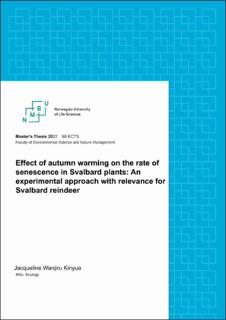| dc.contributor.advisor | Dwinnell, Samantha Paige | |
| dc.contributor.advisor | Loe, Leif Egil | |
| dc.contributor.advisor | Van der Wal, René | |
| dc.contributor.author | Kinyua, Jacqueline Wanjiru | |
| dc.coverage.spatial | Norway, Svalbard | en_US |
| dc.date.accessioned | 2022-07-15T12:36:56Z | |
| dc.date.available | 2022-07-15T12:36:56Z | |
| dc.date.issued | 2022 | |
| dc.identifier.uri | https://hdl.handle.net/11250/3005754 | |
| dc.description.abstract | Phenology is a biological trait sensitive to global warming. Climate change scenarios predict a three-fold increase in temperature and altered rainfall for polar regions. The Svalbard Archipelago, situated at 780 North, and 150 East, is a hotspot for climate change in the arctic, and my study was in the Adventdalen valley of the island. According to climate models, the average annual temperature will increase by about 100C, while the autumn temperature will increase between 7-100C by 2100. My study was an experiment manipulating temperature (open top chambers in combination with heaters elevating temperature by ca. 2 and 7 degrees) and moisture (dry and wet) to investigate their impact on rate of senescence in autumn in three Svalbard reindeer (Rangifer tarandus platyrynchus) forage species. The three species also constitute the three dominant growth forms in Svalbard. Alopecurus borealis represented graminoids, Bistorta vivipara represented forbs, and Salix polaris represented shrubs. It was a transplant experiment to a garden with 12 plots. Counts of green and brown shoots/ leaves were done for about six weeks in late summer-autumn, beginning in mid-August to the end of September when freezing occurred. I found that the graminoid delayed the rate of senescence with higher temperature and moisture. The forb was not affected by moisture but showed a moderate delay in rate of senescence with higher temperatures, while neither moisture nor temperature affected the autumn phenology of the shrub. My analysis shows contradictory results to various other studies that have suggested a greening arctic due to shrubification in the arctic tundra. Graminoids may be the winners of climate change effects in autumn and may affect herbivores positively, by increasing their autumn food quality. Therefore, warmer, and wetter autumns may counteract the effects of harsh winters and propagate the reproductive success of the Svalbard reindeer. As capital breeders, Svalbard reindeer may access higher quality and quantity of vegetation late into autumn and pack fat reserves for over-wintering. My study is just the beginning of a journey toward understanding the link between food availability in autumn and the enhanced fitness of the Svalbard reindeer. | en_US |
| dc.language.iso | eng | en_US |
| dc.publisher | Norwegian University of Life Sciences, Ås | en_US |
| dc.rights | Attribution-NonCommercial-NoDerivatives 4.0 Internasjonal | * |
| dc.rights.uri | http://creativecommons.org/licenses/by-nc-nd/4.0/deed.no | * |
| dc.subject | climate change | en_US |
| dc.subject | autumn warming | en_US |
| dc.subject | senescence | en_US |
| dc.subject | arctic | en_US |
| dc.subject | Svalbard reindeer | en_US |
| dc.subject | graminoids | en_US |
| dc.subject | forbs | en_US |
| dc.subject | shrubs | en_US |
| dc.subject | Salix polaris | en_US |
| dc.subject | Bistorta vivipara | en_US |
| dc.subject | Alopecurus borealis | en_US |
| dc.subject | global warming | en_US |
| dc.subject | ungulates | en_US |
| dc.subject | herbivores | en_US |
| dc.title | Effect of autumn warming on the rate of senescence in Svalbard plants : an experimental approach with relevance for Svalbard reindeer | en_US |
| dc.type | Master thesis | en_US |
| dc.subject.nsi | VDP::Mathematics and natural science: 400 | en_US |
| dc.description.localcode | M-ECOL | en_US |

